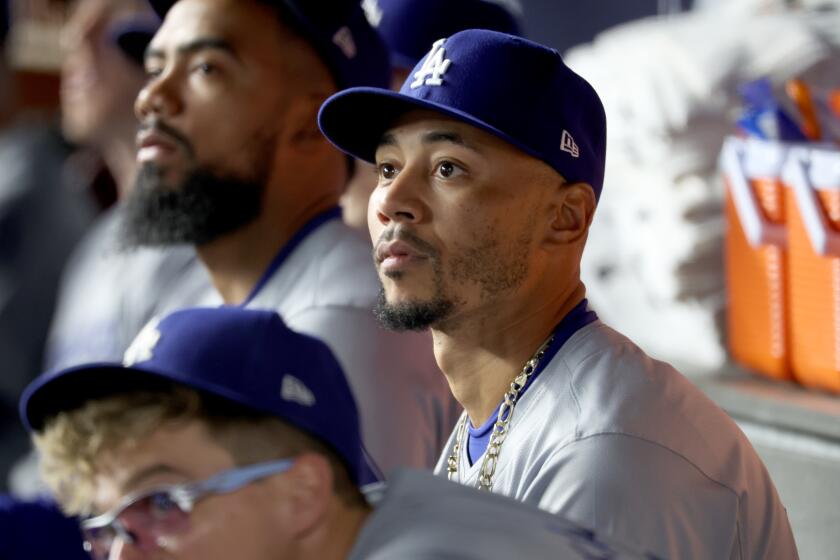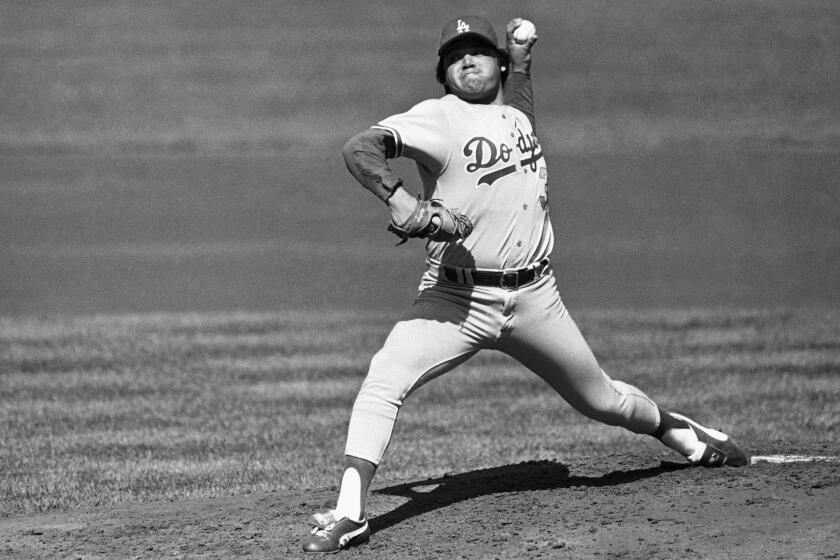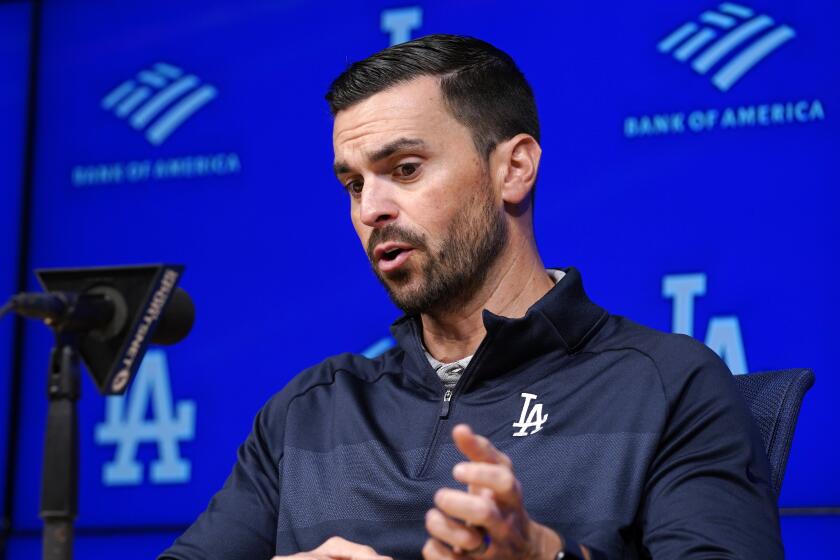Tom Niedenfuer remembers but doesn’t dwell on fateful pitches
Tom Niedenfuer, former Dodgers reliever, made thousands of pitches over a 10-season major league career.
Baseball fans probably remember only two.
Ozzie Smith lined the first over the Busch Stadium wall 25 years ago this week, his improbable walk-off home run giving the St. Louis Cardinals a Game 5 victory over the Dodgers in the 1985 National League Championship Series.
Two days later, Jack Clark crushed a Niedenfuer offering into the left-field pavilion at Dodger Stadium.
Clark’s three-run ninth-inning blast effectively ended the Dodgers’ season, sent the Cardinals to the World Series and turned Niedenfuer into the glum face of the Dodgers’ downfall.
A quarter-century later, it still stings to recount it, Niedenfuer acknowledges. But it doesn’t consume him.
“Every fan’s going to hoot and holler,” he said from his home in Sarasota, Fla. “But I’m not going to let it affect my life.”
Still, he notes, “I sure wish there’d be better highlights in the postseason one of these years to get my stuff off. It’s been twenty-some years and they’re still showing it on ESPN.”
ESPN in 2007 included both home runs among the top 20 moments in league championship series history. Two years before, Cardinals fans voted Smith’s homer — his first as a left-handed batter, after more than 3,000 at-bats from that side of the plate — the greatest moment in Busch Stadium history.
“What can you do?” Niedenfuer said. “It happened.”
Nicknamed Buff (short for Buffalo “because he had a big head,” Tom Lasorda said), the 6-foot-5 right-hander recalls his career fondly, despite his playoff struggles in 1985.
“Looking back on it,” Niedenfuer said, “it’s a very proud feeling that your manager had enough confidence in you to be the guy he put in that situation. I wouldn’t trade that for anything in the world because I loved being out there. But when it happened, all I can remember is … you let the team down.”
Niedenfuer, 51, notched career highs of 19 saves and 106 1/3 innings in 1985, his workload increased because the Dodgers’ other top reliever, Steve Howe, was serving a year-long suspension for drug abuse.
Neidenfuer says he struggled under the strain as the season wore on, and his statistics reflected as much: His earned-run average over the last five weeks of the season was 5.70, more than two runs higher than his career ERA.
Still, dating to his rookie year in 1981, Niedenfuer had not given up an earned run in seven postseason appearances before the light-hitting Smith (career home runs: 28) lined a fastball into the right-field corner in the ninth inning of Game 5.
“It was down and in instead of up and in,” Niedenfuer said, “and when you see the highlights, it cleared the fence by about six inches.”
That was enough.
“It was a home run and that happens,” Niedenfuer said, “but I’d almost consider that one a fluke. He was a great ballplayer, but he wasn’t known for hitting home runs.
“The next one, the next game, that wasn’t a fluke. That thing I thought was going out of the whole stadium.”
With the Dodgers leading, 5-4, in the ninth inning of Game 6, the Cardinals had runners on second base and third base with two out when Clark stepped to the plate. The Cardinals’ most dangerous home run threat unloaded on the first pitch, a fastball over the plate.
Lasorda, criticized for pitching to Clark instead of walking him with first base open, refuses to second-guess himself.
“A second-guesser is someone who doesn’t know anything about the first guess,” the former manager said. “And the second-guesser is somebody who needs two guesses to be right.”
Niedenfuer says that, with left-handed batter Andy Van Slyke on deck, he never even considered walking Clark.
Two innings earlier, he’d struck out Clark on a fastball out of the strike zone after setting him up with several sliders. This time, he and catcher Mike Scioscia planned to alter the pattern.
“We decided on a fastball away, which obviously wasn’t away and wasn’t the right call,” Niedenfuer said.
Niedenfuer was traded to the Baltimore Orioles in 1987 and later played for the Seattle Mariners and Cardinals, ending his career with a 36-46 record, 97 saves and a 3.29 ERA. Collusion by club owners forced him into retirement in 1990.
“I was still a very serviceable, above-average relief pitcher,” he said. “But I couldn’t get signed. …
“That was kind of a bitter way to end a career.”
An avid golfer and outdoorsman, Niedenfuer later received part of a $280-million settlement between owners and the players’ union and has not worked since leaving baseball.
He and wife Judy Landers, a former actress and Playboy cover model, are the parents of two college-age daughters, aspiring singer-actresses Lindsey and Kristy Landers, who front a pop rock band called Official Hot Mess.
Spooked by the 1994 Northridge earthquake, the family moved to Florida from Beverly Hills 14 years ago.
Still, Niedenfuer’s infamy among Dodgers fans lives on, courtesy of two October blasts, Clark’s in particular.
“It’s just the way it is,” the former reliever said. “Jack hit a lot of home runs. He got paid to hit; I got paid to pitch. Great moments in baseball usually are made by two people, not one.”
In 1985, Niedenfuer learned that lesson twice in three days.
More to Read
Are you a true-blue fan?
Get our Dodgers Dugout newsletter for insights, news and much more.
You may occasionally receive promotional content from the Los Angeles Times.










